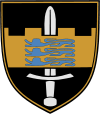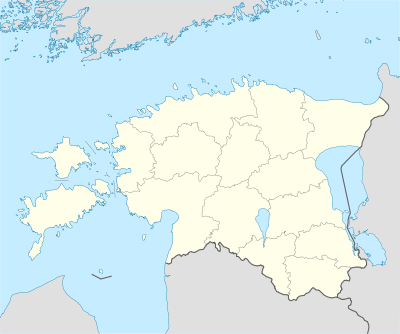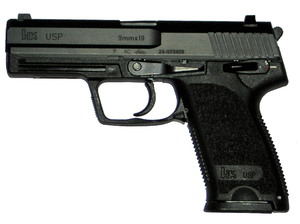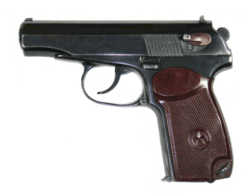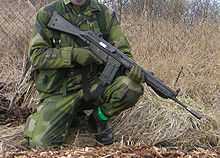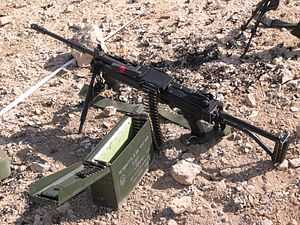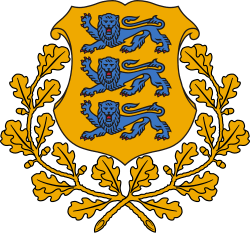Estonian Land Forces
| Estonian Land Forces | |
|---|---|
| Maavägi | |
|
Estonian Land Forces emblem | |
| Active | 1918–present |
| Country |
|
| Role | Land defence |
| Equipment |
Main article: Modern equipment of the Maavägi |
| Engagements |
War of Independence Iraqi war (2003) Afghanistan War (2001) |
| Commanders | |
| Commander | Brigadier General Artur Tiganik[1] |
The Estonian Land Forces (Estonian: Maavägi), unofficially referred to as the Estonian Army, is the name of the unified ground forces among the Estonian Defence Forces where it has an offensive military formation role. It is currently also the largest military branch with the average size during the peacetime with around 6,000 soldiers, conscripts and officers.
The Maavägi development priorities are the capability to participate in missions outside the national territory and the capability to perform operations to protect the territory of Estonia, also in co-operation with the Allies. The Maavägi component of the operational structure consists of an infantry brigade and a homeland security structure. Deployable infantry battalion tactical group and some deployable CS, CSS units will developed in the Army structure in accordance with NATO Force Proposals requirements. Infantry brigade will act as a training and support frame for deployable units. Homeland security structure units will have the capability to carry out territorial military tasks and support civil structures.
The Land Forces are structured according to the principle of a reserve force which means that the main part of the defence forces of the state are units in a trained reserve. For a state with few human and economic resources, a reserve force based on the will of defence of the citizens is the only viable form of national defence.
In peacetime the reservists conduct normal lives and the state takes care of their training and the procurement of equipment and weapons. In wartime the reservists are mobilized into military units. The reserve units are formed on the territorial principle, i.e. conscripts from one area are called up at one time to one unit and after service they are sent to the reserve as one unit. The Estonian Army is always in constant defence readiness in co-operation with the other services.
Interwar history
The 1st and 2nd Divisions were created during the Estonian War of Independence, the 2nd Division in December 1918-January 1919. The Scouts Single Infantry Battalion was formed on 21 December 1918.
On 21 November 1928 eight 'Single Infantry Battalions' were created. The peacetime purpose of these battalions was to train conscripts. In wartime the battalion would reorganize itself into a regiment with a similar order of battle as the two initial reaction force regiments covering the eastern and southern borders. Each battalion's peacetime strength was a total 237 soldiers, in a regimental staff, a Signal Platoon, an Engineering Platoon, a Ski-Bicycle Platoon, a Building Platoon, and three infantry companies.
The war time order of battle would have transformed the battalion into a regiment size unit carrying the same unit number and would have included 3 infantry battalions, Signal Company, Engineering Company, Ski-Bicycle Company, Cavalry Company, Building Company, Commandant Commando and a CB Commando. In total of 3153 men.
The 2nd Single Infantry Battalion was located at Tartu; the 3rd Single Infantry Battalion was located at Valga; the 4th at Jõhvi; the 5th at Rakvere; the 6th Single Infantry Battalion was located at Pärnu; the 8th Single Infantry Battalion at Valga; the 9th at Pärnu; and the 10th Single Infantry Battalion was located at Tallinn.
A reorganisation took place on February 1, 1940 and four divisions were created. The 4th Division staff was based in Viljandi. The division was made up by the Pärnu-Viljandi Military District and Valga Military District. The division's last commander was Colonel Jaan Maide. The four divisions were active until the Soviet occupation of Estonia.
On August 17, 1940, after Estonia's accession to USSR, the 22nd Territorial Rifle Corps of the Red Army was formed at Tallinn. It was created as a territorial Estonian body on the basis of military units and institutions of the Estonian Army. All soldiers and officers kept the Estonian Army 1936 uniforms, on which were sewn Soviet insignia. The first commander of the 22nd Territorial Rifle Corps was a former major general of the Estonian Army, Gustav Yonson, who was later arrested by the NKVD and shot. Initially, most of the corps' officer posts were occupied by former officers of the Estonian army, but by the middle of June 1941 - even before the German invasion of the Soviet Union - most of them were arrested and replaced by newcomers from the Soviet Red Army officers.
Many of the Estonian officers of the 22nd Territorial Rifle Corps body were arrested and died in 1941 - 1942 in camps in the Soviet Union; many were shot. The former commander of the 180th Rifle Division, 22nd Corps, Richard Tomberg, survived after dismissal only because since 1942 he has been claimed by the Frunze Military Academy as a teacher . He was arrested in February 1944 (he was released from the camp and rehabilitated in 1956.) Some officers of the 22nd Rifle Corps, among whom was Alfons Rebane, managed to escape from the authorities in the period between the dismissal of the army and the plan for their arrest. Someone managed to escape abroad, others came out of hiding only after the arrival of German troops in July - August 1941, some of them volunteered for the Estonian units that fought on the side of Nazi Germany, or to enlist in the Estonian organisations controlled by the German authorities.
The 22nd Territorial Rifle Corps was part of the 'operational army' during World War II from 22 June 1941 to 31 August 1941. On June 22, 1941 the corps headquarters was stationed in Rev.
Organization
The Estonian Land Forces actively uses seven sizes of military unit: the Lahingpaar (English: Fire and maneuver team), the Salk (English: Fireteam), the Jagu (English: Section), the Rühm (English: Platoon), the Kompanii (English: Company), the Pataljon (English: Battalion), and the Brigaad (English: Brigade). The Diviis or in (English: Division) is not in active use.
Peacetime structure
Source: Jane's World Armies Issue 23 - 2008
Tapa Garrison: is also for the HQ Northeastern Defence District and fields the 1st Artillery, Air Defence, and Engineer Battalions.
Note 2: Tallinn is HQ Northern Defence District, HQ Estonian Navy, and garrison for the Guard Battalion.


- 1st Infantry Brigade (Tapa)
- Scouts Battalion (Paldiski), professional rapid reaction unit armed with CV-90
- Kalev Infantry Battalion (Paldiski)
- Viru Infantry Battalion (Jõhvi)
- Engineer Battalion (Tapa)
- Artillery Battalion (Tapa)
- Air Defence Battalion (Tapa)
- Combat Service Support Battalion (Paldiski)
- 2nd Infantry Brigade (Luunja Parish)
- Kuperjanov Infantry Battalion (Võru)
- Combat Service Support Battalion (Võru)
Wartime structure
The Maavägi is an army that is based on the principles of the Military reserve force both for practical and historical reasons. The relatively small peacetime Army will be reinforced during wartime by the military reservists of the Estonian Defence League (Estonian: Kaitseliit). Once fully mobilized the Maavägi can man and arm during the conflict the following wartime structure:
- 2 infantry brigades, one of them mechanized.
- 2 air-defence battalions
- 2 engineer battalions
- 2 artillery battalions
- 2 combat support service battalions
- 2 scouts companies
- 2 anti-tank companies
- 2 signal companies
Personnel
Professional units
Currently there are two professional infantry battalions (Scouts Battalion and the Kalev Battalion) in ground forces. There is also a Estonian Special Operations Force.
Equipment
Firearms
Grenades
| Name | Origin | Type | Detonation | Photo | Notes | |
|---|---|---|---|---|---|---|
| Grenades | ||||||
| F-1 | |
Hand grenade | Fuse |  |
||
| RGD-5 | |
Hand grenade | Fuse |  |
||
| m/56 | |
Hand grenade | Fuse | |||
Anti-tank and anti-structure weapons
| Name | Origin | Type | Calibre | Photo | Notes | |
|---|---|---|---|---|---|---|
| Anti-tank missiles | ||||||
| MILAN 2 | |
Anti-tank guided missile | 115 mm |  |
||
| MAPATS | |
Anti-tank guided missile | 148 mm | 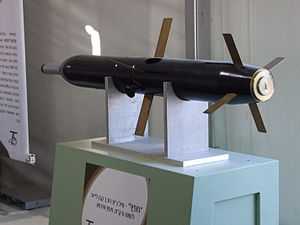 |
||
| B-300 | |
Shoulder-fired missile | 82 mm |  |
||
| FGM-148 Javelin | |
Fire-and-forget anti-tank missile | 127 mm | |
350 Javelin Guided Missiles, 120 Command Launch Units (CLU) to be purchased from the United States.[13] | |
| AT4 | |
Shoulder-fired missile | 84 mm | |
||
| Instalaza C90-CR | |
Shoulder-fired missile | 90 mm |  |
Used by the 1st Infantry Brigade and conscripts.[14] | |
| Type 69 RPG | |
Shoulder-fired missile | 85 mm | .jpg) |
Withdrawn from service. | |
| Recoilless rifles | ||||||
| Carl Gustav | |
Recoilless rifle | 84 mm | 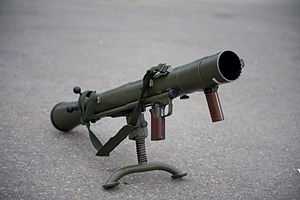 |
Variants M2 and M3.[15] | |
| Pvpj 1110 | |
Recoilless rifle | 90 mm | 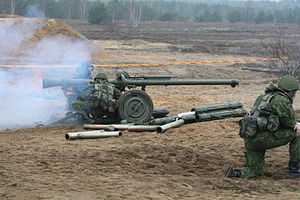 |
130 units.[16] | |
| M40A1 | |
Recoilless rifle | 106 mm | 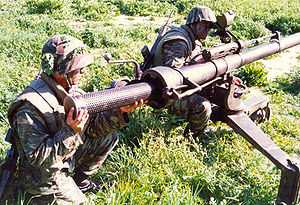 |
30 units.[16] | |
Air-defence
| Name | Origin | Type | Number | Photo | Notes | |
|---|---|---|---|---|---|---|
| Anti-aircraft missiles | ||||||
| Mistral | |
Surface-to-air missile | 25 ? |
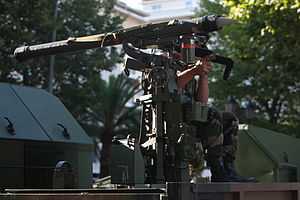 |
First batch of 25 launchers. Additional units have been purchased since.[17] | |
| Anti-aircraft artillery | ||||||
| ZU-23-2 | |
Twin-barreled autocannon | 98 |  |
||
| Air defence radar | ||||||
| GIRAFFE AMB | |
Early-warning radar | 5 |  |
||
| Ground Master 403 | |
Early-warning radar | 2 | |||
Artillery
| Name | Origin | Type | Number | Photo | Notes | |
|---|---|---|---|---|---|---|
| Mortars | ||||||
| M252 | |
Mortar | 80 |  |
M252 is a 81 mm medium mortar which is operated by a three man team.[18] | |
| B455 | |
Mortar | 41 | B455 is a 81 mm medium mortar.[19] | ||
| NM 95 (L-16A1) | |
Mortar | 10 | 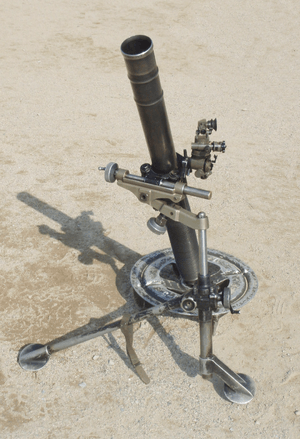 |
L-16A1, also known as NM 95, is a 81 mm medium mortar which is operated by a three man team.[19] | |
| m/41D | |
Mortar | 165 |  |
m/41D is a 120 mm heavy mortar which is operated by a five man team.[19] | |
| 2B11 | |
Mortar | 14 | 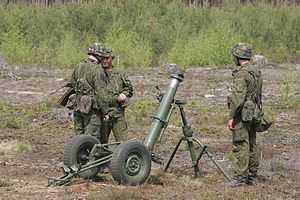 |
2B11 is a 120 mm heavy mortar which is operated by a five man team.[19] | |
| Howitzers | ||||||
| FH-70 | |
Towed howitzer | 24 |  |
FH-70 is a 155 mm towed howitzer.[19] | |
| H63 (D-30) | |
Towed howitzer | 42 |  |
D-30 is a 122 mm towed howitzer. Estonian army uses the H63 variant purchased from Finland.[19] | |
Armoured vehicles
| Name | Origin | Type | Number | Photo | Notes | |
|---|---|---|---|---|---|---|
| Armoured combat vehicles | ||||||
| CV9035NL | |
Infantry fighting vehicle | 44 |  |
Estonian government has agreed to buy 44 CV9035NL from the Netherlands.[20][21] | |
| Sisu Pasi | |
Armoured personnel carrier | 139 |  |
XA-180: 60 units purchased from Finland. XA-188: 81 units purchased from the Netherlands. Deliveries will be completed by 2015.[19] | |
| BTR-80 | |
Armoured personnel carrier | 20 | .jpg) |
Being phased out. Handed over to the Estonian Defence League.[19] | |
| BTR-70 | |
Armoured personnel carrier | 2 | 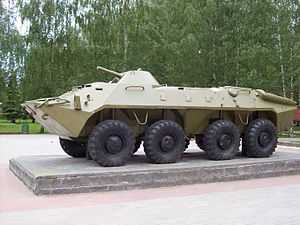 |
Being phased out. Used as training vehicles.[19] | |
| Mamba Alvis-4 | |
Armoured personnel carrier | 7 | |
||
| Biber (Tank) | |
Armoured vehicle-launched bridge | 2 | 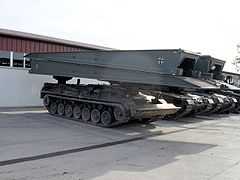 |
Estonian government has agreed to buy 2 Biber Armoured vehicle-launched bridges from the Netherlands.[22] | |
| Bergepanzer (Tank) | |
Armoured Recovery Vehicle | 2 | 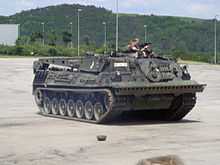 |
Estonian government has agreed to buy 2 Bergepanzer Armoured recovery vehicles from the Netherlands.[22] | |
| Pionierpanzer (Tank) | |
Armoured engineer vehicle | 2 |  |
Estonian government has agreed to buy 2 Pionierpanzer Armoured engineer vehicles from the Netherlands.[22] | |
| BRDM-2 | |
Armoured personnel carrier | 7 |  |
Used by the Estonian Police. Estonian police has withdrawn the vehicles. | |
General-purpose vehicles
| Name | Origin | Type | Number | Photo | Notes | |
|---|---|---|---|---|---|---|
| Trucks and transporters | ||||||
| Mercedes-Benz Unimog | |
General-purpose truck |  |
Mostly Unimog 416 and 435/1300 series models. Over 300 vehicles in use. Used as ambulance, transport and on other purposes in the military. | ||
| MAN mil gl | |
Military logistics vehicle | 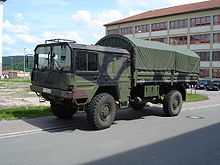 |
MAN 4520, 4620 and 4640 series models. Also used as artillery tractors. | ||
| Mercedes-Benz 1017A | |
General-purpose truck | 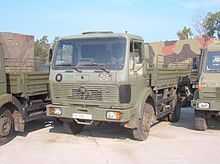 |
|||
| DAF YA 4440 | |
General-purpose truck | |
|||
| Saurer 2DM | |
General-purpose truck | 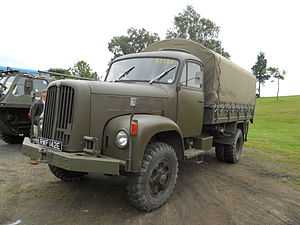 |
Being phased out. | ||
| Light vehicles | ||||||
| Mercedes-Benz 250 GD | |
Light utility vehicle |  |
|||
| Chevrolet CUCV | |
Light utility vehicle |  |
M1008, M1009 and M1010 series models. | ||
| Volvo Tgb | |
High-mobility utility vehicle |  |
Volvo Tgb 11, 13 and 20 series models. | ||
| Volvo | |
High-mobility utility vehicle | 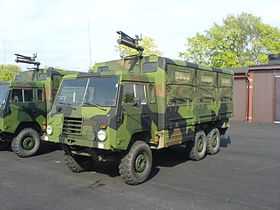 |
|||
| Bandvagn 206 | |
All Terrain Tracked Vehicle | 100 |  |
||
| Logistics vehicles | ||||||
| Mercedes-Benz 4150 | |
Military recovery vehicle |  |
|||
| Sisu E13TP | |
Military logistics vehicle | 2 |  |
Used as Ground Master 403 radar carriers.[23] | |
| Motorcycles | ||||||
| Husqvarna 258A MT | |
Motorcycle |  |
Motorcycles are used for a variety of liaison and reconnaissance tasks. | ||
| Border Guard Vehicles | ||||||
| Arctic Cat | |
Sled |  |
|||
| Arctic Cat | |
ATV |  |
|||
| Bicycles | |
Bicycle |  |
|||
Weapons
Although the defence force employs various individual weapons to provide light firepower at short ranges, the standard weapons used by the ground force are the domestically upgraded variants of the 7.62mm AK4 and 5.56mm Galil-AR assault rifles,[24] as well as the 9mm variant of the MP5 submachine gun for special operations force.[25] The primary sidearms are the 9mm PM and USP semi-automatic pistols.[26] Some units are supplemented with a variety of specialized weapons, including the Galil-ARM and Negev light machine gun, to provide suppressive fire at the fire-team level.[27] Indirect fire is provided by the M-69 and CG M3 grenade launchers.[28] The 18.53mm Benelli-M3T dual-mode shotgun is used for door breaching and close-quarters combat.[29] The domestically produced modification of the 7.62mm M14 selective fire automatic rifle TP2 and Galil-S are used by the snipers,[30] along with the 8.6mm Sako TRG and 12.7mm Hecate II heavy sniper rifles are used long-range marksmen.[31] Hand grenades, fragmentation and smoke grenades along with the grenade launcher systems, such as the HK-GLM and HK-79N,[32] are also used.
The defence force also employs various crew-served weapons to provide medium and heavy firepower at ranges exceeding that of individual weapons. The 7.62mm MG-3 and KSP-58 are the ground force standard medium machine guns. The 12.7mm Browning M2HB heavy machine gun is generally used as a vehicle-mounted machine gun used by motorised infantry. The ground force uses two types of mortar for indirect fire support when heavier artillery may not be appropriate or available. The smallest of these are the 81mm M252,[18] B455 and L16A1 mortars that normally assigned at the infantry company level.[33] At higher echelon, infantry battalions are supported by a section of 120mm M-41D and 2B11 mortars,[33] which are usually employed by motorized units. Fire support for infantry units is provided by towed howitzers, including the lighter 122mm D-30H63 and heavier 155mm FH-70 field howitzers.[33]
The ground force utilizes a variety of shoulder fired missiles, recoilless rifles and anti-tank guided missiles to provide infantry and mechanized units with an anti-armor capability. The 82mm B-300 is a reusable man-portable anti-tank shoulder-fired missile system.[33] The 84mm AT4 is an unguided projectile that can destroy armor and bunkers at ranges up to 500 meters. The 90mm C90-CR is a disposable, shoulder-fired and one-man operated grenade launcher. Some motorized units are supported by the Pvpj 1110 and M40-A1 recoilless rifles that are mounted on high-mobility utility vehicles.[33] The 115mm MILAN-2 with the night-firing ability and 148mm MAPATS laser-beam riding anti-tank guided missiles are the ground forces main anti-tank weapon systems. The purchase of the 127mm FGM-148 Javelin fire-and-forget anti-tank missiles will increase the ground forces anti-armor units capabilities.[34] The 90mm Mistral is an infrared homing surface-to-air missile,[17] which along with the 23mm ZU-23-2 twin-barreled anti-aircraft cannons mounted on trucks make up the backbone of the defence forces air defence.
Vehicles
The ground force currently does not operate any main battle tanks although some types were in service of the ground force till the Soviet occupation in 1940. In recent years the Estonian MoD has indicated a need to obtain main battle tanks by 2020 according to the national defense development plan.[35] As 2014, the infantry fighting vehicle CV9035 is the ground force's main battle and front troop carrier vehicle which is fitted with a 35mm autocannon turret and carry up to 8 fully equipped soldiers.[36] The ground force's most common armoured vehicles are the Pasi series armoured personnel carriers of which some have been fitted into ambulance and command post vehicles roles. The Pasi 180 and Pasi 188 armoured personnel carriers which are the standard troop carrier vehicles of the ground force and have also been used by the defence forces expeditionary units on peacekeeping operations in Central Asia and Africa.[37] In recent years BTR-80 amphibious armoured personnel carriers have been used as training vehicles and are now being phased out.[38]
Although the ground force currently does not operate any self-propelled howitzers or multiple launch rocket systems the Estonian MoD has also indicated a need to obtain self-propelled howitzers for the 1st Infantry Brigade which will be transformed into a mechanized brigade.[39] While the ground force does not have any utility helicopters, attack helicopters or aircraft of its own, it does operate several types of unmanned aerial vehicles and rotorcrafts.[40] Currently there are no operational armed drones in service of the ground force. In 2014, the Estonian MoD announced that Estonia, along with 12 other NATO members, plans to purchase Global Hawk drone to increase its military reconnaissance capabilities.[41]
The defence force's most common vehicles are the Unimog and DAF series general-purpose trucks and light utility vehicles such as Unimog 416, Unimog 435, DAF YA4440 and MB 250GD. There are also variety of different MAN and Sisu built military logistics vehicles, such as MAN 4520, 4620, 4640, KAT1 and Sisu E13TP, in use of the ground force, which are capable of serving as a cargo/troop carrier, artillery tractors, weapons platform and ambulance, among other roles.
Uniforms
The ESTDCU, is the Estonian version of the digital camouflage uniform and it various models are designed for use in woodland, desert, urban and winter warfare environments.[42]
Defense development plan
Based on a long-term defense development plan, the Land Forces are currently undergoing a modernization program. By the year 2018 the Land Forces are likely to be equipped with modern infantry fighting vehicles, along with the additional armored personnel carriers.[43] The artillery capabilities were greatly increased in 2008 with the purchase of 122mm field howitzers from Finland.[44] The Land Forces are also planning to create tactical air surveillance.
What follows is a partial list of planned equipment purchases for the Defence Forces :

- Armoured vehicles
- 44 Units of CV9035NL First batch (ordered from Netherlands) should arrive by first half of 2016.
- Armoured personnel carriers: 81 units (Sisu XA-188)
- Self-propelled artillery
- Anti-tank systems
- C-90 grenade launchers [45]
- Javelin anti-tank missile ~ 80 launchers (will be taken into service by 2016)
- Anti-air systems
- Medium-range surface-to air missile lunchers
Main bases of Estonian Land Forces
- Jägala army base, expected to enter service in 2014 (CANCELLED)
- Tapa army base (1st Infantry Brigade)
References
- ↑ Commanding Officers of the 3 branches of the EDF
- ↑ "Püstol H&K USP" (in Estonian). Estonian Defence Forces.
- ↑ "Püstol PM" (in Estonian). Estonian Defence Forces.
- ↑ "Automaat Galil AR" (in Estonian). Estonian Defence Forces.
- ↑ "Automaat Galil SAR" (in Estonian). Estonian Defence Forces.
- ↑ "Automaat Galil ARM" (in Estonian). Estonian Defence Forces.
- ↑ "Automaat AK-4" (in Estonian). Estonian Defence Forces.
- ↑ "Automaat HK G3A3ZF/G3A4" (in Estonian). Estonian Defence Forces.
- ↑ 9.0 9.1 http://issuu.com/sodur/docs/sodur0613/1?e=7387729/6173960. Missing or empty
|title=(help) - ↑ "Poolautomaatne vintpüss M-14" (in Estonian). Estonian Defence Forces.
- ↑ "Täpsuspüss M-14 TP2" (in Estonian). Estonian Defence Forces.
- ↑ http://www.postimees.ee/2840821/kaitsevagi-lav-ist-ostetud-granaadiheitjad-peavad-eestis-hasti-vastu
- ↑ http://www.postimees.ee/2817722/eesti-kavatseb-usa-lt-osta-tankitorjesusteemi
- ↑ "Kaitsevägi saab Hispaania granaadiheitjad" (in Estonian). ERR.
- ↑ "Granaadiheitja Carl-Gustav M2" (in Estonian). Estonian Defence Forces.
- ↑ 16.0 16.1 "Estonia Land Forces military equipment and vehicles Estonian Army". Armyrecognition.com.
- ↑ 17.0 17.1 "Kaitseministeerium hankis Soomest õhutõrjerelvastust". Estonian MoD.
- ↑ 18.0 18.1 "Eesti saab USA-lt 80 uut miinipildujat" (in Estonian). Postimees.
- ↑ 19.0 19.1 19.2 19.3 19.4 19.5 19.6 19.7 19.8 "Estonia 2008". United Nations.
- ↑ http://uudised.err.ee/v/eesti/e71bc50a-7cc4-4024-886c-4ccaadc80989
- ↑ http://epl.delfi.ee/news/eesti/scoutspataljon-valmistub-umber-relvastuma.d?id=68387437
- ↑ 22.0 22.1 22.2 http://aviationweek.com/blog/netherlands-and-estonia-go-dutch-cv90
- ↑ "Estonian Air Force receives first Sisu 8x8 truck". Army-technology.com.
- ↑ Military assault rifles. EDF military equipment
- ↑ Light arms of the Estonian Ground Force Journal "Kaitse Kodu", Vol. 6, 2009.
- ↑ Military equipment of the Estonian Ground Force: individual and crew served weapons. Kaitseväe Võru Lahingukool, Sõduri Käsiraamat, Võru, 2013.
- ↑ EDF weapons: light machine guns. EDF military equipment
- ↑ EDF weapons: grenade launchers. EDF military equipment
- ↑ EDF weapons: combat shotguns. EDF military equipment
- ↑ EDF weapons: sniper rifles. EDF military equipment
- ↑ EDF weapons: heavy sniper rifles. EDF military equipment
- ↑ EDF weapons: grenade launcher modules. EDF military equipment
- ↑ 33.0 33.1 33.2 33.3 33.4 "Estonian Defence Forces equipment". United Nations.
- ↑ Estonia to Purchase Javelin Anti-Tank Missiles. Estonian Public Broadcasting, 2014
- ↑ Eesti hakkab üles ehitama tankiväge, Forte: Delfi, 2010.
- ↑ Defense Ministry Proposes to Purchase 44 Combat Vehicles, Estonian Public Broadcasting Service, 2014.
- ↑ Kaitsevägi võtab Aafrika missioonile kaasa neli soomukit, Postimees, 2014.
- ↑ Lääne maleva kaitseliitlane taastas vana soomuki, Postimees, 2014.
- ↑ Military's New Development Plan Receives Government Approval, Estonian Public Broadcasting Service, 2013.
- ↑ Eesti õhuruumis hakkavad lendama droonid, Reporter, 2014.
- ↑ Estonia plans to purchase Global Hawk drone to increase its military reconnaissance capabilities., Defence & Security News - Estonia, 2014.
- ↑ Kaitseväe varustus, Riigikogu, 2007.
- ↑ The Long-Term Defence Development Plan
- ↑ Estonia purchasing howitzers from Finland
- ↑ Defence Forces seeking to purchase new rocket launchers from Spain
External links
| ||||||||||||||||||||||||||||||||||||||||||||||||||||||||||||||||||||||||||||||||||||||||||||||||||||||||||||||||||||||||||||||||||||||||||||||||||
| ||||||||||
